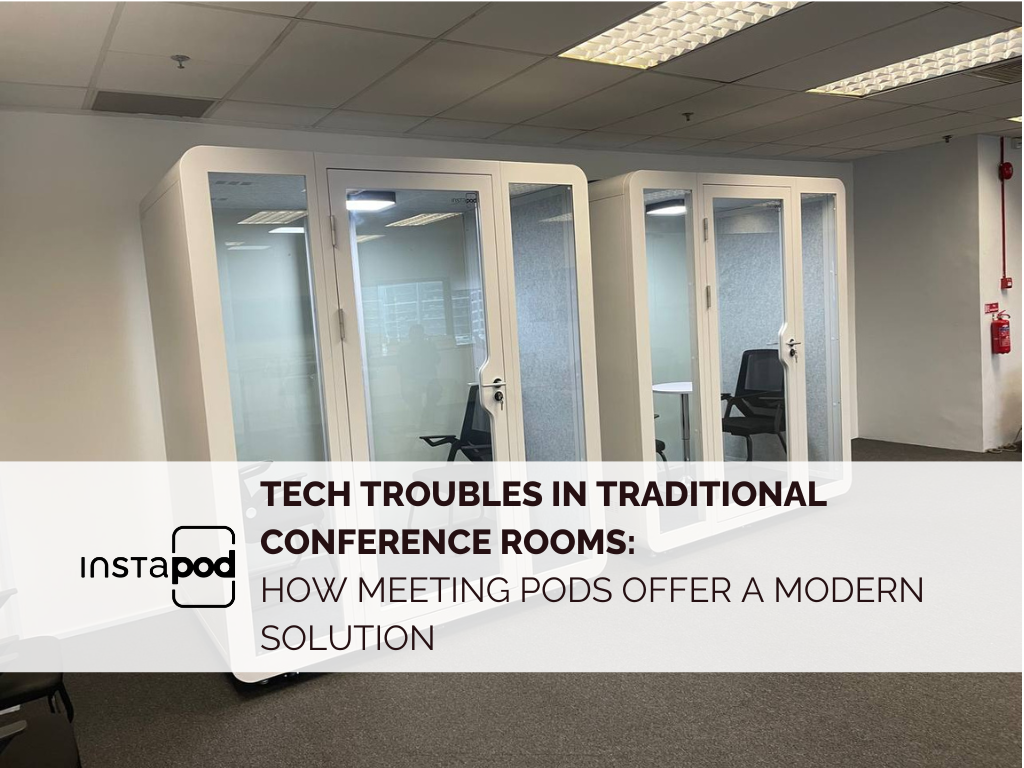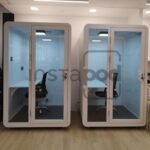No pods added to your quote request yet. Add some now for a free quote!
Tech Troubles in Traditional Conference Rooms: How Meeting Pods Offer a Modern Solution

In today’s fast-paced work environment, seamless communication is crucial for productivity. However, traditional conference rooms often fall short when it comes to accommodating the technological needs of modern businesses. From connectivity issues to poor acoustics, these spaces can hinder rather than help effective collaboration. As businesses strive to create more agile and tech-savvy workspaces, meeting pods have emerged as a modern solution to these persistent tech troubles.
The Tech Challenges of Traditional Conference Rooms
- Connectivity Woes
One of the most common frustrations in traditional conference rooms is unreliable Wi-Fi connectivity. As remote work and virtual meetings become increasingly common, stable internet connections are non-negotiable. However, many conference rooms are plagued by dead zones or insufficient bandwidth, leading to dropped calls and interrupted presentations. The result? Wasted time and a breakdown in communication that can derail even the most carefully planned meetings.
- Outdated Equipment
Conference rooms are often equipped with outdated technology that struggles to keep up with the demands of today’s digital workplace. From malfunctioning projectors to outdated video conferencing systems, these technological relics can create more problems than they solve. Moreover, the lack of user-friendly interfaces often leads to wasted time as employees struggle to set up equipment, troubleshoot issues, and get meetings started on time.
- Poor Acoustics
The acoustics of traditional conference rooms can also pose significant challenges. Echoes, background noise, and poor sound insulation can make it difficult for participants to hear each other clearly, particularly in larger rooms. This can lead to miscommunication, frustration, and a lack of engagement during meetings. Additionally, the need for privacy in discussions can be compromised when sound easily travels through walls or doors, leading to potential breaches of confidentiality.
- Space Constraints
Traditional conference rooms are often designed with a one-size-fits-all approach, which can lead to space constraints during meetings. Large groups may find themselves cramped, while smaller teams might feel lost in a too-large room. This lack of flexibility can be particularly problematic in organizations that have adopted hybrid work models, where meeting sizes and formats can vary widely.
The Rise of Meeting Pods: A Modern Solution
Meeting pods have emerged as a modern, flexible solution to the tech troubles that plague traditional conference rooms. These self-contained, modular spaces are designed to provide a technologically advanced environment that meets the needs of today’s dynamic workforces.
- Enhanced Connectivity
Meeting pods are equipped with state-of-the-art connectivity solutions, ensuring stable and reliable internet access. Many pods come with built-in Wi-Fi boosters or wired connections that eliminate dead zones and ensure that virtual meetings run smoothly. Additionally, these spaces often include integrated power outlets and charging stations, making it easy for employees to keep their devices powered throughout the meeting.
- Advanced Technology Integration
Unlike traditional conference rooms, meeting pods are designed with modern technology in mind. They often come equipped with high-definition video conferencing systems, interactive touchscreens, and wireless presentation tools. This integration of advanced technology not only makes it easier to set up and run meetings but also enhances the overall meeting experience, leading to more productive and engaging discussions.
- Superior Acoustics and Soundproofing
Meeting pods are engineered to provide superior acoustics and soundproofing compared to traditional conference rooms. The materials used in their construction are designed to minimize echoes and block out external noise, creating a quieter, more focused environment. This sound isolation is particularly beneficial for confidential discussions, as it ensures that conversations remain private and free from interruptions.
- Flexible and Scalable Solutions
One of the key advantages of meeting pods is their flexibility. These modular spaces can be easily reconfigured or relocated to meet the changing needs of a business. Whether a team requires a small pod for a one-on-one meeting or a larger pod for group collaboration, there are options available to suit various needs. Additionally, the scalability of meeting pods allows organizations to add or remove units as needed, making them a cost-effective solution for growing businesses.
Conclusion
sAs businesses continue to evolve, the limitations of traditional conference rooms are becoming increasingly apparent. The tech troubles associated with these spaces can hinder productivity, disrupt communication, and create frustration among employees. Meeting pods offer a modern solution to these challenges by providing technologically advanced, flexible, and acoustically superior spaces that enhance the overall meeting experience.
Incorporating meeting pods into the workplace is not just about solving current problems; it’s about future-proofing your office environment. As the demand for remote work and virtual collaboration grows, businesses need to invest in solutions that support seamless communication and adaptability. Meeting pods represent a forward-thinking approach that aligns with the needs of the modern workforce, ensuring that your team can collaborate effectively in a space designed for today’s digital age.
Check these out too!
-
Meeting Pod in Malaysia: The Quiet Space You NeedDecember 5, 2025/0 Comments
-
Acoustic Pods: Bringing Back Private CallsDecember 5, 2025/
-
How Workplace Pod Reduce Office DistractionsDecember 5, 2025/




